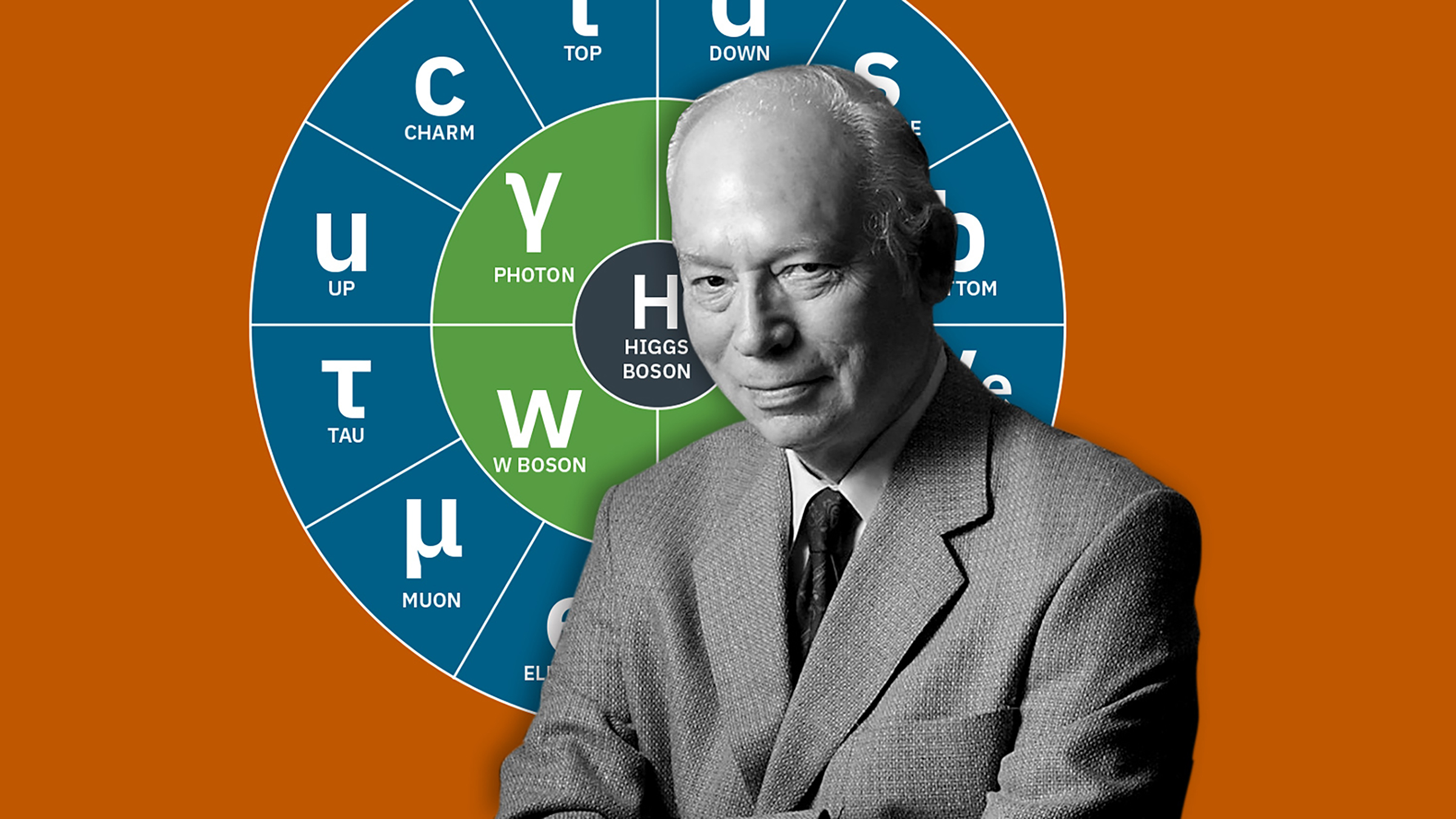A Physicist’s Search for Beauty
Steven Weinberg aimed to distill the rules of physics down to their simplest, most beautiful essence.

Here in part 2 of our continuing remembrance of Steven Weinberg, we're diving a little deeper into what we know because of him. Weinberg was one of the world's greatest theoretical physicists, and his passing last year was deeply felt not only by us here at The University of Texas at Austin, but by a broad community of scientists and science-loving people. Weinberg summed up the goal of his life's work as: "to know why things are the way they are." To him, that meant distilling the rules of physics down to their simplest, most beautiful essence.
What They're Saying
After his passing, the online world was abuzz with tributes to Weinberg. Here are a few from beyond the UT Austin community:
"Scientists, no less than composers, have styles. Einstein and Richard Feynman were rebellious, most comfortable when they were 'thinking different'. Weinberg was not like that. His approach was scholarly. … If Einstein and Feynman call to mind Beethoven, Weinberg calls to mind Bach." - Frank Wilczek, professor of physics at the Massachusetts Institute of Technology
"Working with Steve taught me to think deeply and clearly to define the problem to be solved before launching into solutions." - Helen Quinn, professor of particle physics and astrophysics emerita, SLAC National Accelerator Laboratory
"Steven Weinberg, one of the greatest thinkers of our age, has died. With an astounding ability to see into the deep workings of nature, Steve profoundly shaped our understanding of the universe. His passing is a colossal loss to science and the world." - Brian Greene, professor of physics and mathematics at Columbia University and co-founder of the World Science Festival
"Oh no. One of the best physicists we had; one of the best thinkers of any variety. Steven Weinberg exhibited extraordinary verve and clarity of thought through the whole stretch of a long and productive life." - Sean Carroll, theoretical physicist CalTech
"[Weinberg was] one of the most accomplished scientists of our age, and a particularly eloquent spokesperson for the scientific worldview. Steve remained intellectually active to the end. An immeasurable loss." - John Preskill, theoretical physicist at CalTech and former PhD student of Steven Weinberg
"A delightful companion who loved theater, he could recite the poetry of Gerard Manley Hopkins by heart, and wrote profoundly about the mysteries of creation. He loved life and left it reluctantly. He'll be missed." - Lawrence Wright, writer at The New Yorker, book author, screenwriter and playwright
Show Notes
Donate to the Physics Theory Group, in memory of Steven Weinberg
In addition to original interviews, today's episode features excerpts from three interviews:
On the Shoulders of Giants: Steven Weinberg and the Quest to Explain the World (2021), World Science Festival
Physicist Steven Weinberg on His Search for a "Final Theory" (1993), Fresh Air
The Bill Moyers Interview: Steven Weinberg (1990), Bill Moyers
Our theme music was composed by Charlie Harper
Other music for today's show was produced by: Podington Bear
TRANSCRIPT
Bill Moyers: What is it you want to know about the universe?
Steven Weinberg: I just want to know one thing: why things are the way they are.
Marc Airhart: This is Point of Discovery. Here in part 2 of our continuing remembrance of Steven Weinberg, we're going to dive a little deeper into what we know because of him. Weinberg was one of the world's greatest theoretical physicists, and his passing last year was deeply felt not only by us here at The University of Texas at Austin, but by a broad community of scientists and science-loving people. In this 1990 interview with Bill Moyers, Weinberg summed up the goal of his life's work as: "to know why things are the way they are."
SW: We now have a picture that underlies atomic physics in terms of the properties of elementary particles, it's sometimes called the Standard Model ... And then you ask why is that true? Well. That's what I want to do, I want to trace these chains of why down to their roots.
BM: Almost like a five-year-old child who goes around asking his or her parents why? Why is the bird singing?
SW: Yes, that's right. We want to be thoroughly unpleasant and keep asking, why is that true? And when you get an answer, we ask well, why is that true? And the amazing thing is that we can go pretty far, but in doing it we discover some remarkable things about the universe. One of the things we discover is that these chains of explanations seem to converge to a common source. Because it doesn't matter whether you ask why is the sky blue or why is water wet, you always get down to this level of elementary particles. … and also we find that things get simpler as you get toward the roots of the chains of explanation.
BM: What do you mean they get simpler?
SW: You have to say less and less as you get deeper and deeper. There are fewer and fewer principles. We're beginning to get a feeling that we're getting rather close to the roots.
MA: In writing, we have a mantra in writing, that could just as well have been Steven Weinberg's: "simplify, simplify, simplify." The first big step for him was to show that — at really high energies — two of the four forces of nature were actually different manifestations of the same force. It was really quite a remarkable leap of imagination. These two forces seemed so different — one holds a magnet to your fridge — the other plays a role in the fusion reaction that fuels the sun. It would be like saying if you turn up your car stereo loud enough, The Beatles and Run DMC are actually the same band. Okay, maybe that's not the best analogy, but you know what I mean. That work earned Weinberg a Nobel Prize in Physics -- and it became a central pillar of something called the Standard Model.
Katherine Freese: … there's no question that the work that he did, that led to the creation of the Standard Model of Particle Physics, was absolutely groundbreaking. Not just for particle physics, but also for cosmology, which is the field I work in. So, every single day, we are using the backbone of what he gave us.
MA:That's UT Austin cosmologist Katherine Freese. The Standard Model is this simple chart that describes all the known particles and forces in the universe and how they relate (except gravity, but we'll come back to that). It did super well: it made predictions that were later tested and confirmed. It explained a lot of what we know about the universe. It brought order out of chaos.
WF: First of all there was something beautiful because it put in the same theory various forces — electromagnetism, the weak force — they were all kind of cast in a unified language.
MA: That's UT Austin physicist Willy Fischler. The Standard Model evolved over the years as particle physics experiments filled in missing bits and identified new particles. But it was built in a way that allowed it to accommodate these modifications. Rather than weakening the model, these new insights made it stronger. It's remarkable how the model is flexible enough to accommodate every experiment that's come along so far.
WF: You do this, you do that, it always fits. Okay? [laughs] You know. To find a theory that does that, it's highly non-trivial. .... You scatter electrons from nuclei, you scatter electrons from this, you scatter nucleons on nucleons, whatever you do, and it all fits.
MA: And yet, despite all that success, physicists were not 100% happy, especially Steven Weinberg.
MA: If you want to understand why things are the way they are, the Standard Model is the best thing since sliced bread -- but it still leaves some physicists unhappy. Why? Professor Weinberg explains in a documentary from the producers of the World Festival of Science.
SW: But it works in an almost boringly repetitive way, we keep testing it. The discovery of the Higgs Boson a few years ago turned out to just fit what was expected. ... It would be tragic if the only thing we did at the Large Hadron Collider or anywhere else was to go on elaborating the verification of the Standard Model — and because the Standard Model is certainly not the end of the story, no one thinks it is. It has a lot of unexplained features like numerical quantities, ratios of masses, we don't know where they come from. It doesn't include gravitation, which is a big thing not to include. And we're not — we're happy with it as far as it goes, we desperately want to go beyond it, and we may not be able to in our lifetimes.
MA: Not only does the Standard Model not include gravity, it can't explain dark matter, which makes up most of the mass of the universe.
SW: None of the particles of the Standard Model have the right properties to make up the dark matter. So five-sixths of the mass of the universe is not in the form of anything described by the Standard Model. Well, it's something we ought to know more about! [audience laughs]
MA: For much of the rest of his career, Weinberg searched for a simpler — and more complete explanation for why the world is the way it is. Some have called it the Theory of Everything. Weinberg felt that one of its features would have to be beauty.
SW: … it's not easy to say what you mean by a beautiful theory, but I think it's something like the beauty of a tight, highly structured art form like a sonata or a sonnet.
MA: This is from a conversation he had in 1993 with Marty Moss-Coane for the radio program Fresh Air.
SW: You know, when you hear a classical sonata, you have the feeling that no note could be changed, that you would not want to rewrite a single bar of the music. ... Physical theories have that kind of beauty of a sonnet or a sonata. When they're beautiful, I think they're beautiful because there's nothing in them that you can imagine to be different.
Marty Moss-Coane: Well, is that the feeling that you get that you're on the right path, you talk about a feeling of inevitability?
SW: That's right, we are looking for theories that give us that sense of inevitability. The Standard Model of Elementary Particles is a long step in that direction, compared to the mishmash of miscellaneous facts that we physicists had to learn when I was a graduate student. But it's not, it's not all the way. There are elements in the Standard Model which are quite arbitrary, and are just put in to make the theory agree with experiment. And it's those arbitrary, and hence ugly, things that make us sure it's not the final answer.
MA: In the decades following his Nobel prize, Weinberg worked on string theory, black holes, quantum gravity and many other interesting problems. There are few areas of theoretical physics that he didn't leave his fingerprints on. Though he never cracked the code on the Theory of Everything, he left behind a rich tapestry of relationships — explorers and protégés — the people he inspired along the way, who will help carry on the search.
MA: That's our show. On Monday, March 21, UT Austin is hosting a memorial lecture in honor of Steven Weinberg, featuring his fellow Nobel Laureate, MIT's Frank Wilczek. This event is free and open to the public — both in person on the UT Austin campus — and virtually. You can find out more on our website at pointofdiscovery.org.
MA: Point of Discovery is a production of The University of Texas at Austin's College of Natural Sciences and is a part of the Texas Podcast Network. The opinions expressed in this podcast represent the views of the hosts, and not of The University of Texas at Austin. Our website is at pointofdiscovery.org. There you'll find links to interviews with and about Steven Weinberg, as well as a link to donate to his Theory Group at UT Austin.
MA: Special thanks today to UT Austin's Willy Fischler and Katherine Freese, and our Department of Physics.
MA: Our theme music was composed by Charlie Harper. If you like our show, be sure and tell your friends. We're available wherever you get your podcasts, including Apple Podcasts, Google Podcasts and Spotify. Our senior producer is Christine Sinatra. Thanks for listening — and stay safe out there!



